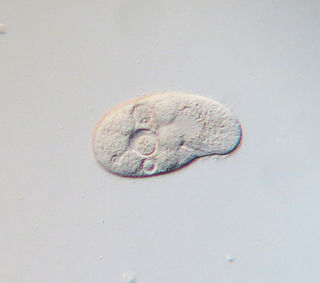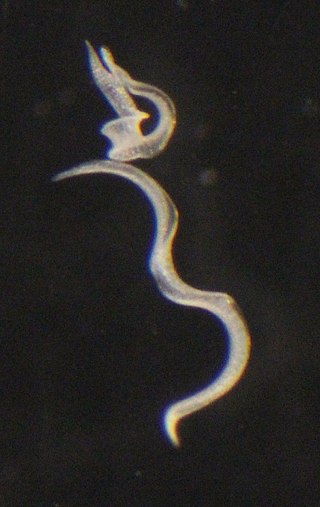The plagiopylids are a small order of ciliates, including a few forms common in anaerobic habitats.

The oligotrichs are a group of ciliates, included among the spirotrichs. They have prominent oral cilia, which are arranged as a collar and lapel, in contrast to the choreotrichs where they form a complete circle. The body cilia are reduced to a girdle and ventral cilia. In Halteria and its relatives, they form bristles or cirri; however these forms may be closer relatives of the stichotrichs than of other oligotrichs. These organisms are very common in plankton communities, especially in marine systems. Usually found in concentrations of about 1 per ml, they are the most important herbivores in the sea, the first link in the food chain.

Stentor, sometimes called trumpet animalcules, are a genus of filter-feeding, heterotrophic ciliates, representative of the heterotrichs. They are usually horn-shaped, and reach lengths of two millimeters; as such, they are among the largest known extant unicellular organisms. They reproduce asexually through binary fission.

Colpoda is a genus of ciliates in the class Colpodea, order Colpodida, and family Colpodidae.
Karyorelictea is a class of ciliates in the subphylum Postciliodesmatophora. Most species are members of the microbenthos community, that is, microscopic organisms found in the marine interstitial habitat, though one genus, Loxodes, is found in freshwater.

The ciliates are a group of alveolates characterized by the presence of hair-like organelles called cilia, which are identical in structure to eukaryotic flagella, but are in general shorter and present in much larger numbers, with a different undulating pattern than flagella. Cilia occur in all members of the group and are variously used in swimming, crawling, attachment, feeding, and sensation.

Frontonia is a genus of free-living unicellular ciliate protists, belonging to the order Peniculida. As Peniculids, the Frontonia are closely related to members of the genus Paramecium. However, whereas Paramecia are mainly bacterivores, Frontonia are capable of ingesting large prey such as diatoms, filamentous algae, testate amoebas, and even, in some circumstances, members of their own species. In bacteria-rich saprobic conditions, Frontonia leucas can live as a facultative bacterivore.

Climacostomum is a genus of unicellular ciliates, belonging to the class Heterotrichea.

Colpidium colpoda are free-living ciliates commonly found in many freshwater environments including streams, rivers, lakes and ponds across the world. Colpidium colpoda is also frequently found inhabiting wastewater treatment plants. This species is used as an indicator of water quality and waste treatment plant performance.
Euplotes petzi is a species of littoral ciliates, first found near King George Island.

Loxodidae is a family of karyorelict ciliates.
Remanella is a genus of karyorelict ciliates, belonging to family Loxodidae. Whereas Remanella inhabits brackish and marine waters, Loxodes – the other loxodid genus – is a freshwater taxon.
Geleiidae is a family of karyorelict ciliates. It is sometimes synonymized with family Aveliidae.

Armophorea is a class of ciliates in the subphylum Intramacronucleata. . It was first resolved in 2004 and comprises three orders: Metopida, Clevelandellida, and Armophorida. Previously members of this class were thought to be heterotrichs because of similarities in morphology, most notably a characteristic dense arrangement of cilia surrounding their oral structures. However, the development of genetic tools and subsequent incorporation of DNA sequence information has led to major revisions in the evolutionary relationships of many protists, including ciliates. Metopids, clevelandellids, and armophorids were grouped into this class based on similarities in their small subunit rRNA sequences, making them one of two so-called "riboclasses" of ciliates, however, recent analyses suggest that Armophorida may not be related to the other two orders.

Kentrophoros is a genus of ciliates in the class Karyorelictea. Ciliates in this genus lack a distinct oral apparatus and depend primarily on symbiotic bacteria for their nutrition.
Wilbertomorphidae is a family of karyorelictean ciliates. The family is monotypic, because it contains a single genus Wilbertomorpha with a single known species, Wilbertomorpha colpoda.

Tracheloraphis is a genus of ciliates in the family Trachelocercidae.
Miamiensis avidus is a species of unicellular marine eukaryote that is a parasite of many different types of fish. It is one of several organisms known to cause the fish disease scuticociliatosis and is considered an economically significant pathogen of farmed fish. M. avidus is believed to be the cause of a 2017 die-off of fish and sharks in the San Francisco Bay.
Parablepharismea is a class of free-living marine and brackish anaerobic ciliates that form a major clade of obligate anaerobes within the SAL group, together with the classes Muranotrichea and Armophorea.
Holosticha is a genus of littoral ciliates.











